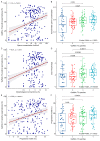Expression of the O-Glycosylation Enzyme GalNAc-T3 in the Equatorial Segment Correlates with the Quality of Spermatozoa
- PMID: 30262754
- PMCID: PMC6212898
- DOI: 10.3390/ijms19102949
Expression of the O-Glycosylation Enzyme GalNAc-T3 in the Equatorial Segment Correlates with the Quality of Spermatozoa
Abstract
We question whether the expression of GalNAc-T3, the only known O-GalNAc-transferase present in germ cells, is correlated with qualitative and functional parameters of spermatozoa. We investigated the expression of GalNAc-T3 in ejaculated spermatozoa with immunocytochemistry in swim-up purified and acrosome-reacted spermatozoa from quality-control semen donors and in semen samples from 206 randomly selected men representing a broad spectrum of semen quality. Using donor ejaculates and immunofluorescence detection we found that expression of GalNAc-T3 and the presence of the immature O-glycans Tn and T localized to the equatorial segment of spermatozoa. The proportion of GalNAc-T3-positive spermatozoa in the ejaculate increased after swim-up and appeared unaffected by induction of acrosomal exocytosis. The fraction of spermatozoa with equatorial expression of GalNAc-T3 correlated with classical semen parameters (concentration p = 9 × 10-6, morphology p = 7 × 10-8, and motility p = 1.8 × 10-5) and was significantly lower in men with oligoteratoasthenozoospermia (p = 0.0048). In conclusion, GalNAc-T3 was highly expressed by motile spermatozoa and the expression correlated positively with the classical semen parameters. Therefore, GalNAc-T3 expression seems related to the quality of the spermatozoa, and we propose that reduced expression of GalNAc-T3 may lead to impaired O-glycosylation of proteins and thereby abnormal maturation and reduced functionality of the spermatozoa.
Keywords: GALNT3; GalNAc-T3; Male fertility; Mucin-type O-linked glycosylation; Semen quality; Spermatozoa.
Conflict of interest statement
The authors declare no conflict of interest. The funders had no role in the design of the study; in the collection, analyses, or interpretation of data; in the writing of the manuscript, and in the decision to publish the results
Figures





References
-
- Skakkebaek N.E., Rajpert-De Meyts E., Buck Louis G.M., Toppari J., Andersson A.-M., Eisenberg M.L., Jensen T.K., Jorgensen N., Swan S.H., Sapra K.J., et al. Male Reproductive Disorders and Fertility Trends: Influences of Environment and Genetic Susceptibility. Physiol. Rev. 2016;96:55–97. doi: 10.1152/physrev.00017.2015. - DOI - PMC - PubMed
-
- Lindsay T.J., Vitrikas K.R. Evaluation and treatment of infertility. Am. Fam. Physician. 2015;91:308–314. - PubMed
-
- Bonde J., Ernst E., Jensen T., Hjollund N., Kolstad H., Henriksen T., Scheike T., Giwercman A., Olsen J., Skakkebaek N. Relation between semen quality and fertility: A population-based study of 430 first-pregnancy planners. Lancet. 1998;352:1172–1177. doi: 10.1016/S0140-6736(97)10514-1. - DOI - PubMed
-
- Slama R., Eustache F., Ducot B., Jensen T.K., Jorgensen N., Horte A., Irvine S., Suominen J., Andersen A.G., Auger J., et al. Time to pregnancy and semen parameters: A cross-sectional study among fertile couples from four European cities. Hum. Reprod. 2002;17:503–515. doi: 10.1093/humrep/17.2.503. - DOI - PubMed
-
- Buck Louis G.M., Sundaram R., Schisterman E.F., Sweeney A., Lynch C.D., Kim S., Maisog J.M., Gore-Langton R., Eisenberg M.L., Chen Z. Semen quality and time to pregnancy: The longitudinal investigation of fertility and the environment study. Fertil. Steril. 2014;101:453–462. doi: 10.1016/j.fertnstert.2013.10.022. - DOI - PMC - PubMed
MeSH terms
Substances
Grants and funding
LinkOut - more resources
Full Text Sources
Other Literature Sources
Molecular Biology Databases

